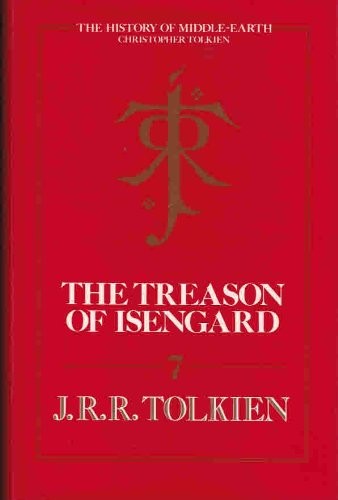504 pages
English language
Published July 13, 1989 by Unwin Hyman.
the history of the Lord of the rings, part two The History of Middle-earth ;

504 pages
English language
Published July 13, 1989 by Unwin Hyman.
The Treason of Isengard is the second volume of The History of The Lord of the Rings and the seventh volume of The History of Middle-earth.
The Treason of Isengard continues the account of the creation of The Lord of the Rings started in the earlier volume, The Return of the Shadow. In this book, following the long halt in the darkness of the Mines of Moria with which The Return of the Shadow ended, is traced the great expansion of the tale into new lands and new peoples south and east of the Misty Mountains; the emergence of Lothlorien, of Ents, of the Riders of Rohan, and of Saruman the White in the fortress of Isengard.
In brief outlines and penciled drafts dashed down on scraps of paper are seen the first entry of Galadriel, the earliest ideas of the history of Gondor, the original meeting of Aragorn and …
The Treason of Isengard is the second volume of The History of The Lord of the Rings and the seventh volume of The History of Middle-earth.
The Treason of Isengard continues the account of the creation of The Lord of the Rings started in the earlier volume, The Return of the Shadow. In this book, following the long halt in the darkness of the Mines of Moria with which The Return of the Shadow ended, is traced the great expansion of the tale into new lands and new peoples south and east of the Misty Mountains; the emergence of Lothlorien, of Ents, of the Riders of Rohan, and of Saruman the White in the fortress of Isengard.
In brief outlines and penciled drafts dashed down on scraps of paper are seen the first entry of Galadriel, the earliest ideas of the history of Gondor, the original meeting of Aragorn and Eowyn, its significance destined to be wholly transformed. Conceptions of what lay ahead are seen dissolving as the story took its own paths, as in the account of the capture of Frodo and his rescue by Sam Gamgee from Minas Morgul, written long before J.R.R. Tolkien actually came to that point in the writing of The Lord of the Rings.
A chief feature of the book is a full account of the original Map, with re-drawings of successive phases, which was long the basis and accompaniment of the emerging geography of Middle-earth. An appendix to the book describes the Runic alphabets as they were at that time, with illustrations of the forms and an analysis of the Runes used in the Book of Mazarbul found beside Balin's Tomb in Moria.